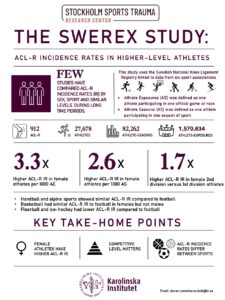Key words: Anterior Cruciate Ligament; Epidemiology; Women in sport
This blog is based on a recently published study in BJSM (1).
Why is this study important?
Anterior cruciate ligament (ACL) injuries are a major problem for athletes involved in pivoting sports at all levels(2-4). Understanding how often these injuries happen, who is most at risk, and which sports see the highest rates can help us understand where we need to direct our efforts for injury prevention (5). Few studies have directly compared ACL incidence rates (IR) in female and male athletes within the same sport, competitive level, time period, and with comparable exposure (2). The SWEREX study (SWEdish nationwide incidence and REturn to sports after ACLR[X]) aims to compare ACL reconstruction (ACL-R) rates in higher-level athletes across six sports and over various seasons.
How Did the Study Go About This?
The study used data from the Swedish National Knee Ligament Registry (SNKLR) (6), a comprehensive National Quality Registry (NQR)(7). To gain a complete picture, the data was matched with seasonal information from six sports organizations: football, handball, basketball, ice hockey, floorball, and alpine skiing.
The study focused on higher-level athletes defined as athletes participating in the two highest divisions in team sports and athletes competing in official International Ski and Snowboard Federation (FIS).
To ensure accurate comparisons, the researchers employed two key methods, used in the literature, to quantify athlete exposure:
- Athlete Exposures (AE) was defined as one athlete participating in one official game or race.
- Athlete Seasons (AS) was defined as one athlete participating in one season of sport.
ACL-R in higher-level athletes was defined as:
- Primary or revision ACL-R
- ACL injury within 3 months (before or after) of an official sporting event
- ACL injury within the same sport they were participating in
This approach allowed for a robust calculation of ACL-R incidence rates in females and males across the six sports. A total of 912 ACL-R were identified within a cohort of 27,678 athletes across 82,263 athlete seasons and a staggering 1,570,634 athlete exposures.
What Did the Study Find?
The results revealed significant differences in ACL-R incidence rates:
- Differences between sexes: Female athletes competing at the same level as males had a higher incidence of ACL-R, approximately 3.3 times more when looking at AE and 2.6 times more when looking at AS.
- Differences between competition level: Second division female athletes had a 1.7 times higher ACL-R IR compared to their first division counterparts.
- Sport Variability: When comparing football to handball and alpine skiing, these showed similar incidence rates. Basketball had comparable incidence in females to football but lower in males. Both floorball and ice hockey showed lower rates than football.
Key Take-Home Points
Female Athletes Have Higher ACL-R IR: Females competing in the same sports as males face a significantly higher incidence rates of ACL-R, emphasizing the need for targeted prevention programs and adherence to proven strategies.
Competitive Level Matters: . Second-division athletes experienced a higher incidence, potentially due to limited access to good training facilities or medical teams helping with injury awareness and prevention.
ACL-R Incidence Rates Differ Between Sports: Some sports, like ice-hockey and floorball, have lower rates compared to football, while other sports like handball, alpine skiing and basketball (for female athletes) show comparable incidence rates. Understanding these differences can help athletes, coaches, and sports organizations focus injury prevention efforts where they’re needed most.
This study adds to our understanding of ACL-R incidence in sports. By focusing on these findings, sports organizations can work toward fewer injuries, better support for athletes, and longer, healthier careers in sports.

Authors: Daniel Castellanos Dolk, MD, Henrik Hedevik, MSc, Helena Stigson, MSc, PhD, Per Wretenberg, MD, PhD, Joanna Kvist, RPT, PhD, Anders Stålman, MD, PhD
References:
- Castellanos Dolk D, Hedevik H, Stigson H, Wretenberg P, Kvist J, Stålman A. Nationwide incidence of anterior cruciate ligament reconstruction in higher-level athletes in Sweden: a cohort study from the Swedish National Knee Ligament Registry linked to six sports organisations. Br J Sports Med. 2025 Mar 25;59(7):470-479. doi: 10.1136/bjsports-2024-108343. PMID: 39577873; PMCID: PMC12013579.
- Montalvo AM, Schneider DK, Webster KE, Yut L, Galloway MT, Heidt RS, et al. Anterior Cruciate Ligament Injury Risk in Sport: A Systematic Review and Meta-Analysis of Injury Incidence by Sex and Sport Classification. Journal of Athletic Training. 2019 May 1;54(5):472–82.
- Moses B, Orchard J, Orchard J. Systematic Review: Annual Incidence of ACL Injury and Surgery in Various Populations. Research in Sports Medicine. 2012 Jul;20(3–4):157–79.
- Prodromos CC, Han Y, Rogowski J, Joyce B, Shi K. A Meta-analysis of the Incidence of Anterior Cruciate Ligament Tears as a Function of Gender, Sport, and a Knee Injury–Reduction Regimen. Arthroscopy: The Journal of Arthroscopic & Related Surgery. 2007 Dec;23(12):1320-1325.e6.
- Mall NA, Chalmers PN, Moric M, Tanaka MJ, Cole BJ, Bach BR, et al. Incidence and Trends of Anterior Cruciate Ligament Reconstruction in the United States. Am J Sports Med. 2014 Oct;42(10):2363–70.
- Lindqvist Bueneman S, Sernert N, Kvist J, Kartus J. Analysis of the Swedish Knee Ligament Register: Concomitant injuries, revision surgery and smoking render worse results. Knee surg sports traumatol arthrosc. 2024 Nov;32(11):2895–908.
- Fredriksson M, Halford C, Eldh AC, Dahlström T, Vengberg S, Wallin L, et al. Are data from national quality registries used in quality improvement at Swedish hospital clinics? International Journal for Quality in Health Care. 2017 Nov 1;29(7):909–15.